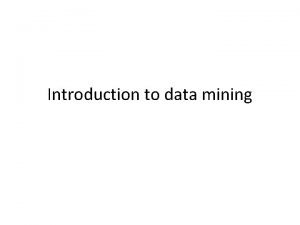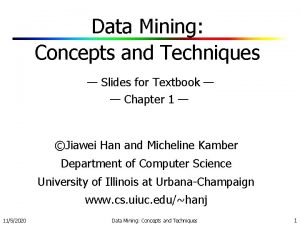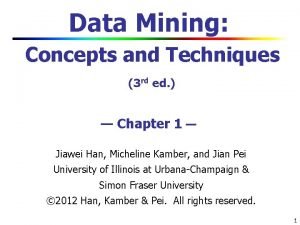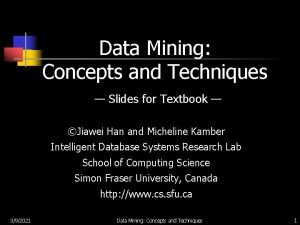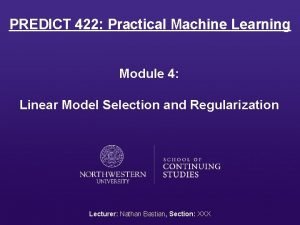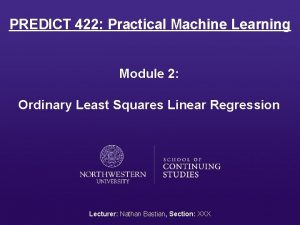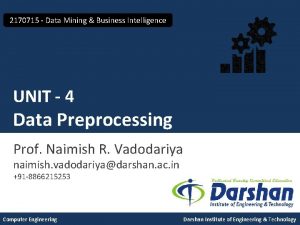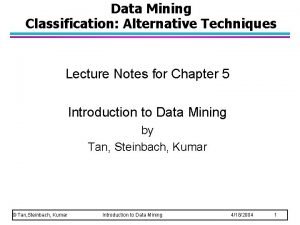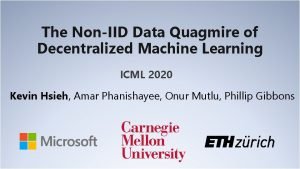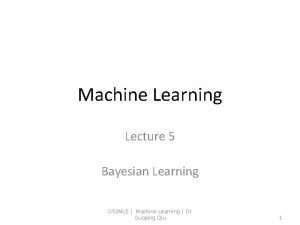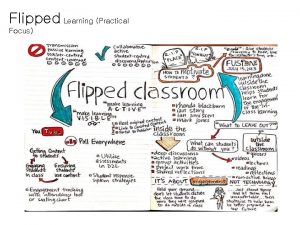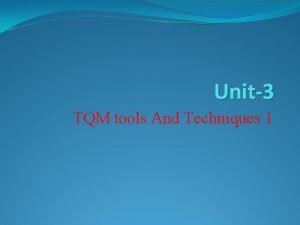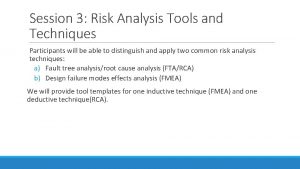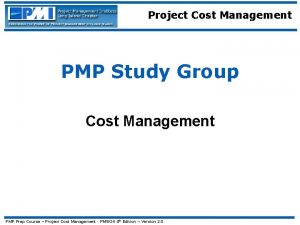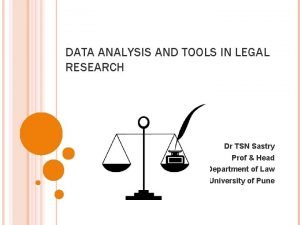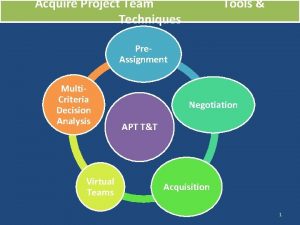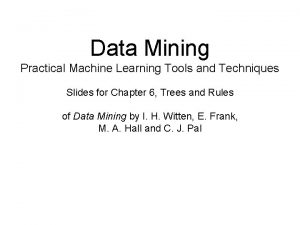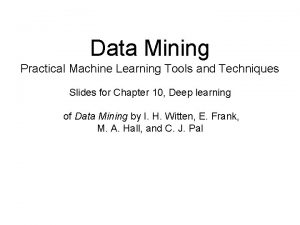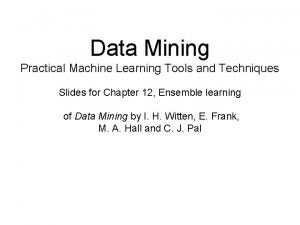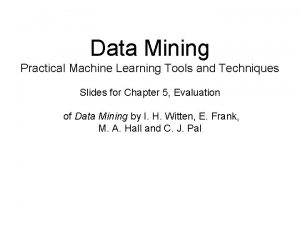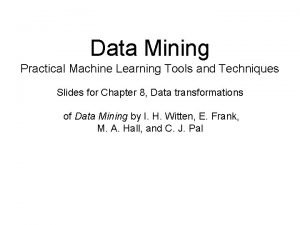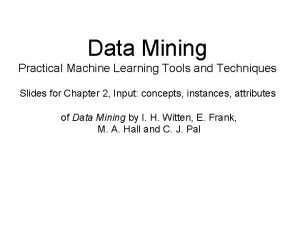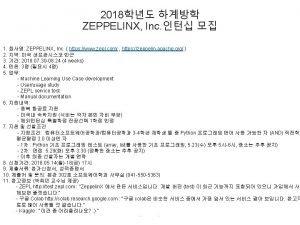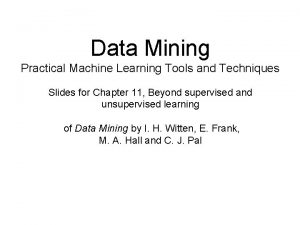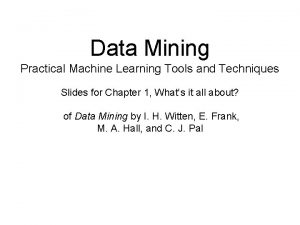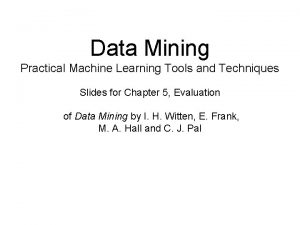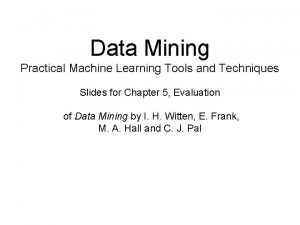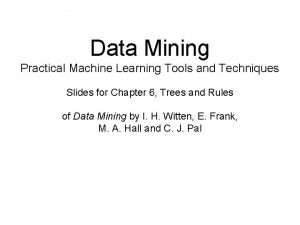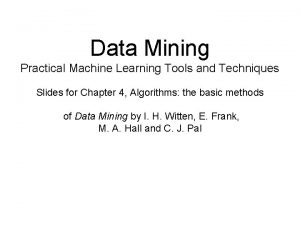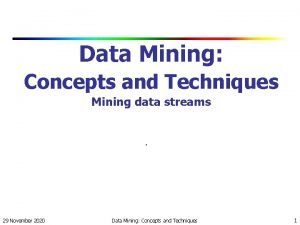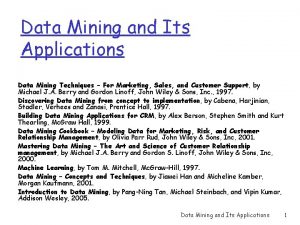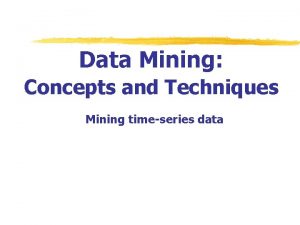Data Mining Practical Machine Learning Tools and Techniques
































































- Slides: 64

Data Mining Practical Machine Learning Tools and Techniques Slides for Chapter 7, Extending instance-based and linear models of Data Mining by I. H. Witten, E. Frank, M. A. Hall and C. J. Pal

Extending instance-based learning and linear models • Instance-based learning • Pruning and reducing the number of exemplars • Weighted attributes • Generalized exemplars and distance functions • Extending linear models • Support vector machines, kernel ridge regression, kernel perceptrons • Multilayer perceptrons and radial basis function networks • Gradient descent • Numeric prediction with local linear models • Model Trees • Learning rule sets with model trees • Locally weighted linear regression 2

Instance Based Learning 3

Instance-based learning Practical problems of 1 -nearest-neighbour scheme: • Slow (but: fast tree-based approaches exist) - Remedy: remove irrelevant data • Noise (but: k -NN copes quite well with noise) - Remedy: remove noisy instances • All attributes deemed equally important - Remedy: weight attributes (or simply select) • Doesn’t perform explicit generalization - Remedy: rule-based NN approach 4

Learning prototypes • Only those instances involved in a decision need to be stored • Noisy instances should be filtered out • Idea: only use prototypical examples 5

Speed up classification, combat noise • David Aha’s IB 2: save memory, speed up classification • Work incrementally • Only incorporate misclassified instances • Problem: noisy data gets incorporated • David Aha’s IB 3: deal with noise • Discard instances that do not perform well • Compute confidence intervals for 1. Each instance’s success rate 2. Default accuracy of the instance’s class • Accept/reject instances according to performance 1. Accept if lower limit of 1 exceeds upper limit of 2 2. Reject if upper limit of 1 is below lower limit of 2 6

Weight attributes • David Aha’s IB 4: weight each attribute (weights can be class-specific) • Weighted Euclidean distance: • Update weights based on nearest neighbor • Class correct: increase weight • Class incorrect: decrease weight • Amount of change for i th attribute depends on |xi- yi| 7

Generalized exemplars • Generalize instances into hyperrectangles • Online: incrementally modify rectangles • Offline version: seek small set of rectangles that cover the instances • Important design decisions: • Allow overlapping rectangles? • Requires conflict resolution • Allow nested rectangles? • Dealing with uncovered instances? 8

Rectangular generalizations • Nearest-neighbor rule is used outside rectangles • Rectangles are rules! (But they can be more conservative than “normal” rules. ) • Nested rectangles are rules with exceptions 9

Separating generalized exemplars Class 1 Class 2 Separation line 10

Generalized distance functions • Problem with Euclidean distance, etc. : only natural for purely numeric datasets • Transformation-based approach to designing distance functions can be applied more generally • Given: some transformation operations on attributes • K* similarity = probability of transforming instance A into B by chance • Average over all transformation paths • Weight paths according their probability (need way of measuring this) • Uniform way of dealing with different attribute types • Easily generalized to give distance between sets of instances 11

Discussion and Bibliographic Notes • Nearest-neighbor methods gained popularity in machine learning through the work of Aha (1992) • Salzberg (1991) suggested that generalization with nested exemplars can achieve high classification accuracy • Wettschereck and Dietterich (1994) argued that these results were fortuitous and did not hold in other domains • Martin (1995) explored the idea that overgeneralization that occurs when hyperrectangles nest or overlap is problematic • The generalized distance function based on transformations is described by Cleary and Trigg (1995) 12

Extending Linear Models 13

Support vector machines • Support vector machines are algorithms for learning linear classifiers • Resilient to overfitting because they learn a particular linear decision boundary: • The maximum margin hyperplane • Fast in the nonlinear case • Use a mathematical trick to avoid creating “pseudo-attributes” • The nonlinear space is created implicitly 14

The maximum margin hyperplane • The instances closest to the maximum margin hyperplane are called support vectors 15

Support vectors • The support vectors define the maximum margin hyperplane • All other instances can be deleted without changing its position and orientation • The hyperplane can be written as 16

Finding support vectors • Support vector: training instance for which �i > 0 • Determining �i and b ? — A constrained quadratic optimization problem • Off-the-shelf tools for solving these problems • However, special-purpose algorithms are faster • Example: Platt’s sequential minimal optimization (SMO) algorithm • Note: the method discussed so far assumes separable data! 17

Nonlinear SVMs • We can create a nonlinear classifier by creating new “pseudo” attributes from the original attributes in the data • “Pseudo” attributes represent attribute combinations • E. g. : all polynomials of degree 2 that can be formed from the original attributes • We can learn a linear SVM from this extended data • The linear SVM in the extended space is a non-linear classifier in the original attribute space • Overfitting often not a significant problem with this approach because the maximum margin hyperplane is stable • There are often comparatively few support vectors relative to the size of the training set • Computation time still an issue • Each time the dot product is computed, all the “pseudo attributes” must be included 18

A mathematical trick • Avoid computing the “pseudo attributes” • Compute the dot product before doing the nonlinear mapping • Example: • Corresponds to a map into the instance spanned by all products of n attributes 19

Other kernel functions • Mapping is called a “kernel function” • Polynomial kernel • We can use others: K() can be written as a dot product in a feature space create by the implicit feature mapping Φ() • Only requirement: • Examples: * 20

Noise • Have assumed that the data is separable (in original or transformed space) • Can apply SVMs to noisy data by introducing a “noise” parameter C • Also known as regularization parameter • C bounds the influence of any one training instance on the decision boundary • Based on the following constraint: 0 i C • A “soft” margin is maximized based on this constraint • Still a quadratic optimization problem • Have to determine C by experimentation 21

Sparse data • SVM algorithms speed up dramatically if the data is sparse (i. e. , many values are 0) • Why? Because they compute lots and lots of dot products • Sparse data can compute dot products very efficiently • Iterate only over non-zero values • SVMs can process sparse datasets with 10, 000 s of attributes 22

Support vector regression • Maximum margin hyperplane only applies to classification • However, idea of support vectors and kernel functions can be used for regression • Basic method is the same as in linear regression: want to minimize error • Difference A: ignore errors smaller than e and use absolute error instead of squared error • Difference B: simultaneously aim to maximize flatness of function • User-specified parameter e defines “tube” 23

More on SVM regression • If there are tubes that enclose all the training points, the flattest of them is used • E. g. : mean is used if 2 e > range of target values • Model can be written as: • Support vectors: points on or outside tube • Dot product can be replaced by kernel function • In contrast to the classification case, the coefficients i may be negative (in the classification case, we have the class values) • No tube that encloses all training points? • Requires trade-off between error and flatness • Controlled by upper limit C on absolute value of coefficients i 24

Examples e=2 e=1 e = 0. 5 25

Kernel Ridge Regression • For classic linear regression using squared loss, only simple matrix operations are needed to find the parameters • This is not the case for support vector regression because a different loss function is used • Requires use of numeric optimization technique such as sequential minimal optimization • Can we combine the power of the kernel trick with the simplicity of standard least-squares regression? • Yes! This yields kernel ridge regression 26

Comments on kernel ridge regression • Like in an SVM, the predicted class value for a test instance is expressed as a weighted sum of dot products • But: all training instances are involved in this sum: • Unlike in an SVM, all training instances participate – not just support vectors • No sparseness in the solution (no support vectors) • Also, loss in ridge regression does not ignore errors smaller than e • Moreover, squared error is used instead of absolute error so regression model is more sensitive to outliers 27

Performing kernel ridge regression • The penalized loss function that is optimized by kernel ridge regression is • The user-specified parameter λ determines closeness of fit to the training data • The coefficients can be found using matrix operations • Standard regression – invert an m m matrix (O(m 3)), m = #attributes • Kernel ridge regression – invert an n n matrix (O(n 3)), n = #instances • Has an advantage if • a non-linear fit is desired or • there are more attributes than training instances 28

The kernel perceptron • We can use the “kernel trick” to make a non-linear classifier using the perceptron learning rule • Observation: in perceptron learning rule, weight vector is modified by adding or subtracting training instances • Hence, we can represent the learned weight vector using all instances that have been misclassified: • This means we can use instead of ( where y is either -1 or +1) • Now swap summation signs: • Can be expressed as: • Can replace dot product by kernel: 29

Comments on kernel perceptron • Finds separating hyperplane in space created by kernel function (if it exists) • But: doesn't find maximum-margin hyperplane • Easy to implement, supports incremental learning • Perceptron can be made more stable by using all weight vectors encountered during learning, not just the last one (yields the voted perceptron) • Weight vectors vote on prediction (vote based on number of successful classifications sinception) 30

Multilayer perceptrons • Using kernels is only one way to build nonlinear classifier based on perceptrons • Can create network of perceptrons to approximate arbitrary target concepts • A multilayer perceptron is an example of an artificial neural network build from perceptrons • Consists of: input layer, hidden layer(s), and output layer • Structure of MLP is usually found by experimentation • Parameters can be found using backpropagation 31

Examples 32

Backpropagation • How to learn the weights given a network structure? • Cannot simply use perceptron learning rule because we have hidden layer(s) • Function we are trying to minimize: error • Can use a general function minimization technique called gradient descent • Activation function needs to provide gradient information: can use sigmoid function instead of threshold function • Loss function also needs to provide gradient information: cannot use zero-one loss, but can use squared error 33

Threshold vs. sigmoid activation function 34

Gradient descent example • Function: x 2+1 • Derivative: 2 x • Learning rate: 0. 1 • Start value: 4 • Can only find a local minimum! 35

Minimizing the error I • Need to find partial derivative of error function with respect to each parameter (i. e. , weight): 36

Minimizing the error II • What about the weights for the connections from the input to the hidden layer? More application of the chain rule… 37

Remarks • The same process works for multiple hidden layers and multiple output units (e. g. , for multiple classes) • Can update weights after all training instances have been processed or incrementally: • batch learning vs. stochastic backpropagation • Weights are initialized to small random values • How to avoid overfitting? • Early stopping: use validation set to check when to stop • Weight decay: add penalty term to error function • How to speed up learning? • Momentum: re-use proportion of old weight change • Use optimization method that employs 2 nd derivative 38

Radial basis function networks • RBF network: another type of feedforward network, with two layers (plus the input layer) • Hidden units represent points in instance space and activation depends on distance to these points • To this end, distance is converted into a similarity score using a Gaussian activation function • Width of Gaussian may be different for each hidden unit • Points of equal activation of units in hidden layer form hypersphere (or hyperellipsoid) as opposed to hyperplane • Output layer is the same as in a multi-layer perceptron 39

Learning RBF networks • Parameters to be learned: centers and widths of the RBFs + weights in output layer • Can learn the two sets of parameters independently and still get fairly accurate models • E. g. : clusters from k-means can be used to form basis functions • Linear model for output layer can be based on fixed RBFs found using clustering, which makes learning very efficient • However, for best accuracy it is best to train the entire network in a fully supervised manner • Can use the same methods that are used for training multilayer perceptrons • Disadvantage of standard RBF networks: no built-in attribute weighting based on relevance • But: can introduce attribute weights into the distance function • RBF networks are related to RBF SVMs, which have a basis function centered on each support vector 40

Stochastic gradient descent • We have seen gradient descent + stochastic gradient descent for learning weights in a neural network • Gradient descent is a general-purpose optimization technique • Can be applied whenever the objective function is differentiable • Actually, can be used even when the objective function is not completely differentiable! • This based on the concept of subgradients, which we will not get into here • One application: learning linear models – e. g. linear SVMs or logistic regression • Very fast, simple method for learning from large datasets 41

Stochastic gradient descent cont. • Learning linear models using gradient descent is easier than optimizing non-linear neural networks • Objective function has a single global minimum rather than several local minima • Stochastic gradient descent is fast, uses little memory and is suitable for incremental online learning • Let us look at how to apply stochastic gradient descent to learn a linear support vector machine 42

Loss functions • For SVMs, the error function (to be minimized) is called the hinge loss 43

Optimizing the hinge loss • In the linearly separable case, the hinge loss is 0 for a function that successfully separates the data • The maximum margin hyperplane is given by the smallest weight vector that achieves 0 hinge loss • Corresponding optimization problem that needs to be solved: user-specified regularization parameter z • But: hinge loss is not differentiable at z = 1; cannot compute gradient for all values of z • Can use subgradient – something that resembles a gradient • Can use 0 at z = 1 • In fact, loss is 0 for z 1, so we can focus on z 1 and proceed as usual with stochastic gradient descent • Also yields a solution if the data is not separable 44

Discussion and Bibliographic Notes • SVMs stem from statistical learning theory (Vapnik 1999) • A good starting point for exploration is a tutorial by Burges (1998) • Soft-margin SVMs were discussed by Cortes and Vapnik (1995) • Tutorial on support vector regression: Smola and Schölkopf (2004) • Schölkopf et al. (1999) present support vector regression with just one parameter instead of two (C and ε) • Fletcher (1987) covers constrained quadratic optimization • The SMO algorithm for training SVMs is due to Platt (1998) • Ridge regression was introduced by Hoerl and Kennard (1970) • Hastie et al. (2009) give a good description of kernel ridge regression • Kernel ridge regression is equivalent to Gaussian process regression, a Bayesian approach that also provides estimates of uncertainty 45

Discussion and Bibliographic Notes • The kernel perceptron is due to Freund and Schapire (1999) • Cristianini and Shawe-Taylor (2000) provide an introduction to support vector machines and kernel-based methods • Shawe-Taylor and Cristianini (2004) and Schölkopf and Smola (2002) cover kernel-based learning in detail • Bishop (1995) provides an excellent introduction to both multilayer perceptrons and RBF networks • Kivinen et al. (2002), Zhang (2004) and Shalev-Shwartz et al. (2007) explore gradient methods for SVMs • Kivinen et al. and Shalev-Shwartz et al. provide heuristics for setting the learning rate for gradient descent 46

Numeric Prediction with Local Linear Models 47

Numeric prediction (aka regression) • Counterparts exist for all classification schemes previously discussed • Decision trees, rule learners, SVMs, etc. • (Almost) all classification schemes can be applied to regression problems using discretization: • Discretize the class into intervals • Predict weighted average of interval representatives (e. g. , midpoints) • Weight according to class probabilities • We will cover a couple of approaches to regression that are based on building local linear models • Model trees (+ a rule learning algorithm based on them) and locally weighted linear regression 48

Regression trees • Like decision trees, but: • Splitting criterion: minimize intra-subset variation • Termination criterion: std. dev. becomes small • Pruning criterion: based on numeric error measure • Prediction: Leaf predicts average class value of instances • Yields piecewise constant functions • Easy to interpret • More sophisticated version: model trees 49

Model trees • Build a regression tree • Each leaf linear regression function • Smoothing: factor in ancestor’s predictions • Smoothing formula: • Same effect can be achieved by incorporating ancestor models into the leaves • Need linear regression function at each node • At each node, use only a subset of attributes to build linear regression model • Those occurring in subtree • (+maybe those occurring in path to the root) • Fast: tree usually uses only a small subset of the attributes 50

Building the tree • Splitting: standard deviation reduction • Termination of splitting process: • Standard deviation < 5% of its value on full training set • Too few instances remain (e. g. , < 4) Pruning: • Heuristic estimate of absolute error of linear regression models: • Greedily remove terms from LR models to minimize estimated error • Proceed bottom up: compare error of LR model at internal node to error of subtree (this happens before smoothing is applied) • Heavy pruning: single model may replace whole subtree 51

Nominal attributes • Convert nominal attributes to binary ones • Sort attribute values by their average class values • If attribute has k values, generate k – 1 binary attributes • i th attribute is 0 if original nominal value is part of the first i nominal values in the sorted list, and 1 otherwise • Treat binary attributes as numeric in linear regression models and when selecting splits • Can prove: best SDR split on one of the new binary attributes is the best (binary) SDR split on original nominal attribute • In practice this process is not applied at every node of the tree but globally at the root node of the tree • Splits are no longer optimal but runtime and potential for overfitting are reduced this way 52

Missing values • Modify splitting criterion: • To determine which subset an instance goes into, use surrogate splitting • Split on the attribute whose correlation with attribute whose value is missing is greatest • Problem: complex and time-consuming • Simple solution: always use the class as surrogate attribute • Class can only be used at training time • Test set: replace missing value with average 53

Surrogate splitting based on class • Choose split point based on instances with known values • Split point divides instances into 2 subsets • L (smaller class average) • R (larger) • m is the average of the two averages • For an instance with a missing value: • Choose L if class value < m • Otherwise R • Once full tree is built, replace missing values with averages of corresponding leaf nodes • Linear regression models can then be built on the completed (“imputed”) dataset 54

Pseudo-code for M 5' • Let us consider the pseudo code for the model tree inducer M 5’ • Four methods: • • Main method: Make. Model. Tree Method for splitting: split Method for pruning: prune Method that computes error: subtree. Error • We will briefly look at each method in turn • We will assume that the linear regression method performs attribute subset selection based on error (discussed previously) • Nominal attributes are replaced globally at the root node 55

Make. Model. Tree (instances) { SD = sd(instances) for each k-valued nominal attribute convert into k-1 synthetic binary attributes root = new. Node root. instances = instances split(root) prune(root) print. Tree(root) } 56

split(node) { if sizeof(node. instances) < 4 or sd(node. instances) < 0. 05*SD node. type = LEAF else node. type = INTERIOR for each attribute for all possible split positions of attribute calculate the attribute's SDR node. attribute = attribute with maximum SDR split(node. left) split(node. right) } 57

prune(node) { if node = INTERIOR then prune(node. left. Child) prune(node. right. Child) node. model = linear. Regression(node) if subtree. Error(node) > error(node) then node. type = LEAF } 58

subtree. Error(node) { l = node. left; r = node. right if node = INTERIOR then return (sizeof(l. instances)*subtree. Error(l) + sizeof(r. instances)*subtree. Error(r)) /sizeof(node. instances) else return error(node) } 59

Model tree for servo data 60

Rules from model trees • PART algorithm generates classification rules by building partial decision trees • Can use the same method to build rule sets for regression • Use model trees instead of decision trees • Use variance instead of entropy to choose node to expand when building a partial tree • Rules that are generated will have linear models on righthand side • Caveat: using smoothed trees may not be appropriate due to the separate-and-conquer strategy used in rule learning • Empirical evidence shows that smoothing does not help • Full trees can be used instead of partial trees at the expense of runtime 61

Locally weighted regression • Locally weighted regression is a numeric prediction method that combines • instance-based learning • linear regression • It is a “lazy” learning method: • Computes new regression function for each test instance at prediction time • Works incrementally • Weights training instances • according to distance to test instance • builds linear regression model from weighted data • requires weighted version of linear regression (straightforward) • Advantage: nonlinear approximation • Slow if implemented using brute-force search; however, fast data structures can be used for the nearest-neighbor search 62

Design decisions • Weighting functions: • • Inverse Euclidean distance Gaussian kernel applied to Euclidean distance Triangular kernel used the same way etc. • Empirically, performance does not appear to depend much on the weighting method that is used • Ideally, weighting function has bounded support so that most training instances receive weight 0 and can be ignored • Smoothing parameter is used to scale the distance function for computation of the weights • Multiply distance by inverse of this parameter • Possible choice: distance to the kth nearest training instance (renders choice of smoothing parameter data dependent) 63

Discussion and Bibliographic Notes • Regression trees were introduced in the “classification and regression trees”, or CART system (Breiman et al. , 1984) • The method of handling nominal attributes and the surrogate device for dealing with missing values were included in CART • M 5 model trees were first described by Quinlan (1992) • The M 5’ version is given by Wang and Witten (1997) • Using model trees (although not partial trees) for generating rule sets has been explored by Hall et al. (1999) • There are many variations of locally weighted learning. • Statisticians have considered using locally quadratic models • They have applied locally weighted logistic regression to classification • Frank et al. (2003) evaluated the use of locally weighted learning in conjunction with Naïve Bayes • Atkeson et al. (1997) provide a survey on locally weighted learning 64
 Mining complex types of data in data mining
Mining complex types of data in data mining Machine learning and data mining
Machine learning and data mining Introduction to azure ml
Introduction to azure ml Multimedia data mining
Multimedia data mining Data mining concepts and techniques slides
Data mining concepts and techniques slides Data mining concepts and techniques
Data mining concepts and techniques Data mining slides
Data mining slides Data mining concepts and techniques slides
Data mining concepts and techniques slides Practical machine learning quiz 4
Practical machine learning quiz 4 Practical machine learning quiz 2
Practical machine learning quiz 2 Query tools in data mining
Query tools in data mining Binning methods in data mining
Binning methods in data mining Association data mining techniques
Association data mining techniques Classification alternative techniques in data mining
Classification alternative techniques in data mining Difference between strip mining and open pit mining
Difference between strip mining and open pit mining Text and web mining
Text and web mining What is kdd process in data mining
What is kdd process in data mining Olap crm
Olap crm Olap database
Olap database Introduction to data mining and data warehousing
Introduction to data mining and data warehousing Unsupervised learning in data mining
Unsupervised learning in data mining Pendekatan unsupervised learning adalah
Pendekatan unsupervised learning adalah Inductive and analytical learning in machine learning
Inductive and analytical learning in machine learning Deductive learning vs inductive learning
Deductive learning vs inductive learning Eager classification versus lazy classification
Eager classification versus lazy classification Strip mining vs open pit mining
Strip mining vs open pit mining Strip mining before and after
Strip mining before and after Data reduction in data mining
Data reduction in data mining What is missing data in data mining
What is missing data in data mining Data reduction in data mining
Data reduction in data mining Data reduction in data mining
Data reduction in data mining Data reduction in data mining
Data reduction in data mining Data cube technology in data mining
Data cube technology in data mining Data reduction in data mining
Data reduction in data mining Arsitektur data mining
Arsitektur data mining Perbedaan data warehouse dan data mining
Perbedaan data warehouse dan data mining Descriptive mining of complex data objects
Descriptive mining of complex data objects Noisy data in data mining
Noisy data in data mining Three-tier data warehouse architecture
Three-tier data warehouse architecture Markku roiha
Markku roiha Data compression in data mining
Data compression in data mining Data warehouse dan data mining
Data warehouse dan data mining Cs 412 introduction to data mining
Cs 412 introduction to data mining Concept learning task in machine learning
Concept learning task in machine learning Analytical learning in machine learning
Analytical learning in machine learning Pac learning model in machine learning
Pac learning model in machine learning Machine learning t mitchell
Machine learning t mitchell Instance based learning in machine learning
Instance based learning in machine learning Inductive learning machine learning
Inductive learning machine learning First order rule learning in machine learning
First order rule learning in machine learning Cmu machine learning
Cmu machine learning Casmuo
Casmuo Cuadro comparativo de e-learning b-learning y m-learning
Cuadro comparativo de e-learning b-learning y m-learning Bsp classification
Bsp classification Training data in machine learning with example
Training data in machine learning with example Practical focus on learning
Practical focus on learning Tqm tools and techniques
Tqm tools and techniques Total quality management tools
Total quality management tools Software quality assurance tools and techniques
Software quality assurance tools and techniques Risk analysis tools and techniques
Risk analysis tools and techniques Cost management pmp
Cost management pmp Principles of pla
Principles of pla Legal research tools and techniques
Legal research tools and techniques Conduct procurement tools and techniques
Conduct procurement tools and techniques Pre assignment
Pre assignment

